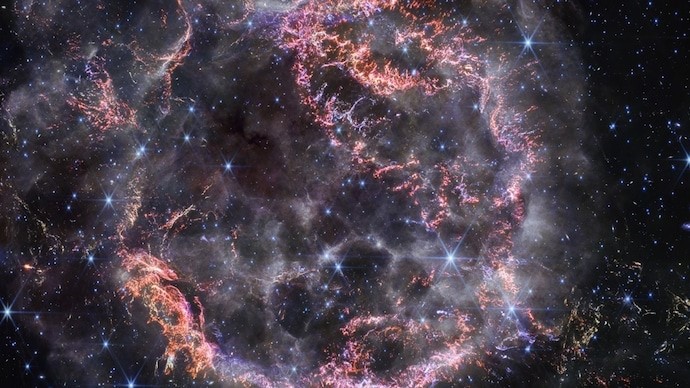
Disclaimer: Copyright infringement not intended.
Context
The Webb's Near-Infrared Camera (NIRCam) has captured Cas A with unprecedented clarity, revealing the intricate aftermath of the star's explosion. This supernova remnant, located 11,000 light-years away in the constellation Cassiopeia, is one of the most extensively studied objects in the universe.
Details
- Cassiopeia A (Cas A) is a well-known and intensely studied supernova remnant (SNR) located in the constellation Cassiopeia, approximately 11,000 light-years away from Earth.
- It represents the remnants of a massive star that exploded in a supernova event, which was observed by Earth's inhabitants around the year 1680.
Key Characteristics of Cassiopeia A
- Supernova Explosion: The supernova that created Cassiopeia A occurred nearly 340 years ago, but its light only reached Earth in the late 17th century. This makes Cas A one of the youngest known supernova remnants in our Milky Way galaxy.
- Structure and Appearance: The remnant spans about 10 light-years in diameter and is composed of rapidly expanding debris from the exploded star. Observations across different wavelengths, including radio, infrared, optical, and X-ray, have revealed various structures and elements within the remnant.
- Elemental Composition: Cassiopeia A is enriched with various heavy elements, including oxygen, silicon, sulfur, and iron. These elements were forged in the supernova explosion and later dispersed into space, eventually becoming part of new stars, planets, and celestial bodies.
- Neutron Star Formation: At the core of Cassiopeia A lies a dense stellar corpse known as a neutron star. This neutron star is a super-dense object formed from the collapsed core of the massive star that underwent the supernova explosion. It's spinning rapidly, emitting powerful beams of radiation, and occasionally emitting pulses of radio waves, thus classified as a pulsar.
Research and Discoveries
- Multi-Wavelength Observations: Astronomers have extensively studied Cas A using various telescopes across different wavelengths. These observations have provided insights into the remnant's dynamics, elemental composition, shockwaves, and the evolution of supernova remnants.
- Elemental Synthesis: Cas A's analysis has significantly contributed to our understanding of nucleosynthesis, the process by which heavier elements are formed in the universe. The supernova explosion in Cas A played a vital role in dispersing these elements into space, enriching the interstellar medium.
- Neutron Star Insights: The neutron star at the center of Cassiopeia A has been a subject of intense study. Researchers use its behavior, including its rapid rotation and occasional emissions, to understand the extreme physics of neutron stars, magnetic fields, and their role in the universe.

Significance and Ongoing Studies
- Astrophysical Laboratory: Cassiopeia A serves as a laboratory for understanding the late stages of stellar evolution, supernova explosions, and the subsequent effects on interstellar material and cosmic evolution.
- Continued Observations: Ongoing observations with advanced telescopes and instruments aim to delve deeper into the structure and dynamics of Cassiopeia A, furthering our understanding of the physics behind supernovae, neutron stars, and their impact on the universe.
Chandra X-ray Observatory
- Purpose and Function: Launched in 1999, Chandra is a space-based telescope designed to observe X-rays from high-energy regions in the universe. It helps astronomers study celestial objects such as black holes, neutron stars, supernova remnants, galaxy clusters, and active galactic nuclei emitting X-rays.
- Observational Capabilities: Chandra has high-resolution X-ray optics that allow it to capture incredibly detailed images of X-ray emissions. It detects X-rays coming from extremely hot regions in the universe, revealing processes involving temperatures in millions of degrees Celsius that are invisible in other wavelengths.
- Discoveries: Chandra has contributed significantly to our understanding of the violent processes occurring in the universe, such as the dynamics of black holes, the behavior of matter in extreme environments, and the interactions of cosmic structures.
- Technology: Chandra uses four sets of nested mirrors to focus X-rays onto its detectors, providing precise and high-resolution images. Its instruments include imaging detectors and spectrometers specifically designed for studying X-ray emissions.
Hubble Space Telescope
- Purpose and Function: Launched in 1990, the Hubble Space Telescope (HST) is one of the most famous telescopes, observing primarily in visible, ultraviolet, and near-infrared wavelengths. It has provided breathtaking images of distant galaxies, nebulae, stars, and planets within our solar system.
- Observational Capabilities: Hubble's location above Earth's atmosphere allows it to capture clear and detailed images with minimal distortion. Its instruments include cameras, spectrographs, and other scientific instruments that enable astronomers to study a wide range of cosmic phenomena.
- Discoveries: Hubble has made numerous groundbreaking discoveries, including observations of distant galaxies and the measurement of the rate of expansion of the universe (Hubble's Law). It has provided key insights into the age of the universe, the formation of galaxies, and the existence of black holes.
- Upgrades and Maintenance: Over its operational life, Hubble has been serviced and upgraded by astronauts during multiple Space Shuttle missions. These servicing missions have extended its lifespan and improved its capabilities, allowing it to continue producing groundbreaking science.
About Cassiopeia
- It is a prominent and easily recognizable constellation in the northern sky.
Overview:
- Location and Visibility: Located in the northern celestial hemisphere, Cassiopeia is visible at different times of the year depending on the observer's latitude. For northern observers, it is circumpolar, meaning it never sets and is visible year-round.
- Shape and Stars: The five main stars that form Cassiopeia's outline are Alpha Cassiopeiae (Shedir), Beta Cassiopeiae (Caph), Gamma Cassiopeiae (Tsih), Delta Cassiopeiae (Ruchbah), and Epsilon Cassiopeiae (Segin). Together, these stars create the distinctive shape that resembles a "W" or an "M."
- Mythological Significance: In Greek mythology, Queen Cassiopeia was punished by the gods for her vanity and boastfulness. She was placed in the sky along with her family as constellations, forever circling the celestial pole.
Key Features and Objects Associated with Cassiopeia:
- Deep-Sky Objects: While not as abundant in deep-sky objects as some other constellations, Cassiopeia hosts several interesting celestial objects, including open star clusters, nebulae, and galaxies.
- The Heart Nebula (IC 1805): A large emission nebula in Cassiopeia resembling a heart shape, it is a region of active star formation and is part of the Perseus Arm of our Milky Way galaxy.
- The Pacman Nebula (NGC 281): Another emission nebula, it is named for its resemblance to the video game character Pac-Man when observed in certain images.
- Open Clusters: Cassiopeia contains several open star clusters, such as Messier 52 (M52) and NGC 457, both of which are visible with binoculars or small telescopes.
- Quasars and Galaxies: Some galaxies and quasars are also found within the boundaries of Cassiopeia, though they may require larger telescopes for observation.
Astronomical Significance:
- Navigation Aid: Cassiopeia is used as a navigational reference for locating other constellations, including the North Star (Polaris) in the constellation Ursa Minor, which lies close to Cassiopeia.
- Astronomical Observations: Astronomers often study objects within Cassiopeia to explore aspects of star formation, stellar evolution, and cosmology.
- Cultural Significance: The constellation's distinctive shape and position in the northern sky have made it a subject of fascination and storytelling across various cultures throughout history.

Conclusion
Cassiopeia A continues to be a crucial object of study in astrophysics, providing astronomers with valuable insights into the life cycle of stars, the formation of heavy elements, and the extreme environments created by supernova explosions. Its observations contribute significantly to our understanding of the universe's fundamental processes.
|
PRACTICE QUESTION
Q. Which of the following is NOT a feature associated with the constellation Cassiopeia?
A) A distinct "W" or "M" shape formed by its five brightest stars
B) It is part of the zodiac constellations
C) The star Beta Cassiopeiae, also known as Caph
D) It is circumpolar for many northern observers
Answer: B)
|




